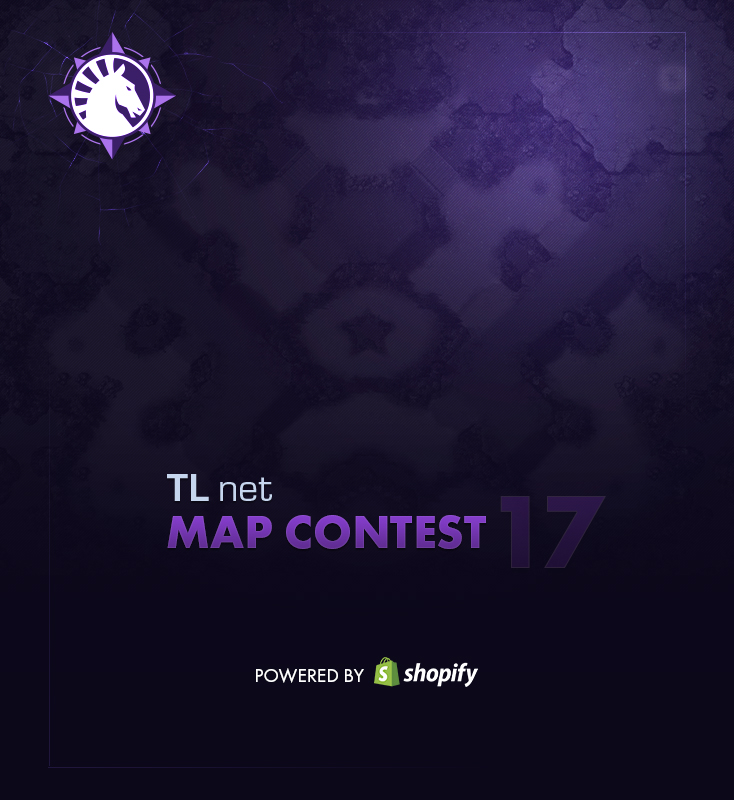
It's time to announce the sixteen finalists of Team Liquid Map Contest #17!
Voting will be open during October 25-30. The WardiTV TLMC Tournament will be held at the same time with progamers testing out the finalist maps.
Some notes as we unveil the maps:
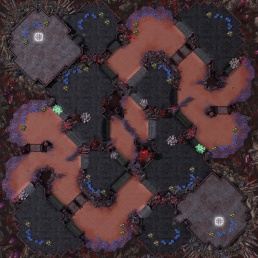 Forward high ground outposts play a major part in defense and coordinating attacks. The linear third is open and easy to access, whereas a triangle third is choked, with an option to partially block a ramp with collapsible rocks.
Forward high ground outposts play a major part in defense and coordinating attacks. The linear third is open and easy to access, whereas a triangle third is choked, with an option to partially block a ramp with collapsible rocks.
Features:
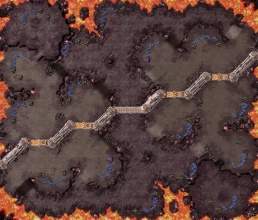 The Silver Wall has 5 openings where units can pass through. Destroying the rocks in the middle of the map significantly changes the attack routes.
The Silver Wall has 5 openings where units can pass through. Destroying the rocks in the middle of the map significantly changes the attack routes.
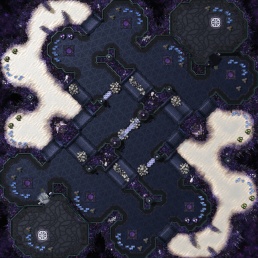 Starchild is a standard map with 14 bases, two of which have double rich gasses. There’s also no Overlord pillars at the naturals. Like a typical standard map there are also two third base options, line of sight blockers and some rocks.
Starchild is a standard map with 14 bases, two of which have double rich gasses. There’s also no Overlord pillars at the naturals. Like a typical standard map there are also two third base options, line of sight blockers and some rocks.
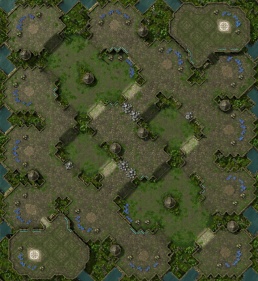 A balanced layout which provides room for many different strategies.
A balanced layout which provides room for many different strategies.
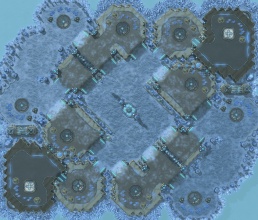 Key points:
Key points:
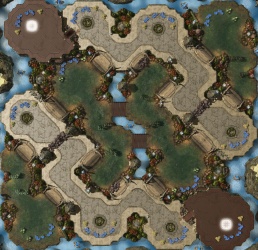 A shorter rush distance and rocks that can open up chokes at key bases pushes the importance of map awareness.
A shorter rush distance and rocks that can open up chokes at key bases pushes the importance of map awareness.
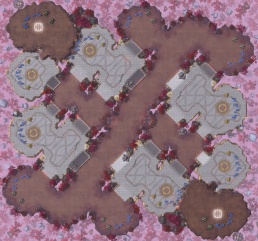 Pink Moon is a two-player rush map. The fastest attack path is lined with two inhibitor zones in medium-small choke points. Going around will let players take better engagements, at the sacrifice of longer movement times. The expansion layout follows a fork pattern, with a high degree of symmetry and subtle tradeoffs in the way players choose to expand.
Pink Moon is a two-player rush map. The fastest attack path is lined with two inhibitor zones in medium-small choke points. Going around will let players take better engagements, at the sacrifice of longer movement times. The expansion layout follows a fork pattern, with a high degree of symmetry and subtle tradeoffs in the way players choose to expand.
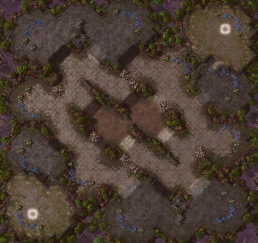 Small rush map with 6 bases per player. Main attack route leads through dangerous lowground, side paths are on the high ground, but blocked by long rocks at one point.
Small rush map with 6 bases per player. Main attack route leads through dangerous lowground, side paths are on the high ground, but blocked by long rocks at one point.
There is Xel'Naga Tower at 5 and 11 o'clock that gives vision of some of the highground side path, it's hidden behind los blockers.
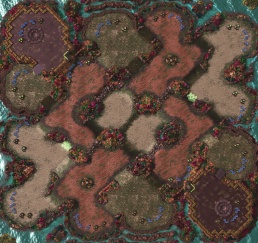 This is a fairly small map with standardized expansion patterns that features 4 cliff levels.
This is a fairly small map with standardized expansion patterns that features 4 cliff levels.
The reason why I think this map belongs to the rush category even though it has 4 cliff levels (besides short rush distance) is because it features a linear third base relatively open on the low ground, while the triangle third attack path would be straightforward and short if the rocks are taken down. Even if the rocks are not taken down, it's still possible to attack that triangle third from the high ground of the base next to it.
Destroying the destructible rocks will easily shorten the travel time of your attacks and also make them quite straight forward towards the opposing enemy expansions.
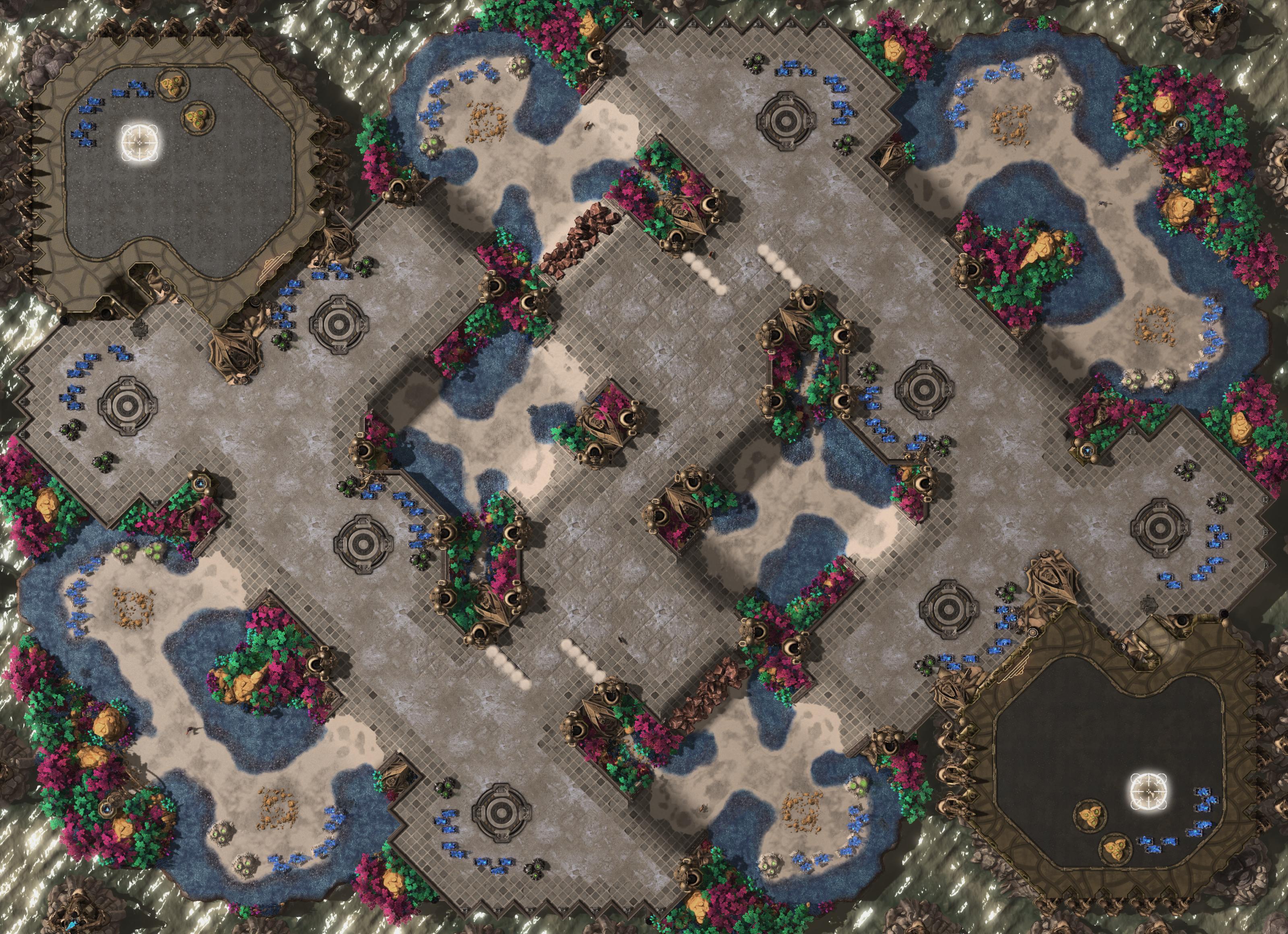 Macro map with a rake layout of 16 bases. There are forward bases between the usual third base locations. Because the third base opens towards the side and creates a cliff towards the middle, the general movement focuses on a wider choke with line-of-sight blockers and ramp near the triangular fourth.
Macro map with a rake layout of 16 bases. There are forward bases between the usual third base locations. Because the third base opens towards the side and creates a cliff towards the middle, the general movement focuses on a wider choke with line-of-sight blockers and ramp near the triangular fourth.
Features:
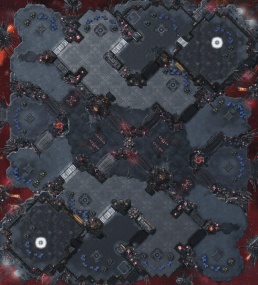 Black Engine is a 5-level macro map with a non-standard format of entrance to the natural base. Which allows you to have a split decision on what you want to take as a third base. All levels have at least one fully operating base.
Black Engine is a 5-level macro map with a non-standard format of entrance to the natural base. Which allows you to have a split decision on what you want to take as a third base. All levels have at least one fully operating base.
Fifth level was introduced as an experimental part of design. But at the same time it looks natural not only for a base but also for army movements.
Corner bases were pushed at low ground.
The map is relatively medium sized and doesn't have a big number of bases. Only 14 standard bases in total.
The area of the main base is a little bit small for Terran players. But it has been done on purpose. In exchange we have a bigger area of natural base. A place to hide and build a third CC (behind vespene geysers; and if you wanna take a linear third), couple more gates, barracks (less distance to move, or once again to hide them from the opponent). Hiding buildings can be relative to any race. So the decision was not one-sided.
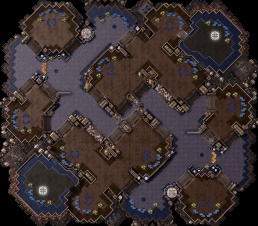 Despite a short rush distance, this map provides a lot of safety early on by restricting movement of armies and allowing players to expand away from the main attack path. Bases are spread horizontally, and become harder to defend the longer the game goes.
Despite a short rush distance, this map provides a lot of safety early on by restricting movement of armies and allowing players to expand away from the main attack path. Bases are spread horizontally, and become harder to defend the longer the game goes.
Features:
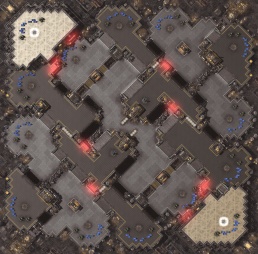 A larger map with baby chokes and shortcuts to keep players on their toes. The linear third expansion is nicely tucked in but has a high-ground with sight-blockers next to it which has to be taken into consideration. The triangular third has several entry points but much tighter chokes. Whatever the choice, the area leading out from the natural provides good flanking opportunities if the attacker overcommits. A Xel'Naga Tower at each side of the center gives vision of important attack paths.
A larger map with baby chokes and shortcuts to keep players on their toes. The linear third expansion is nicely tucked in but has a high-ground with sight-blockers next to it which has to be taken into consideration. The triangular third has several entry points but much tighter chokes. Whatever the choice, the area leading out from the natural provides good flanking opportunities if the attacker overcommits. A Xel'Naga Tower at each side of the center gives vision of important attack paths.
Distinctive features:
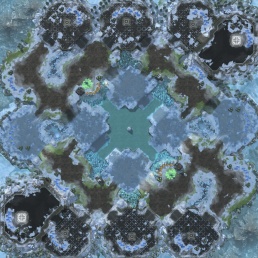 A Macro map with a bit of a twist! Rich bases in the center are blocked by destructible Xel'Naga towers leaving 3 options:
A Macro map with a bit of a twist! Rich bases in the center are blocked by destructible Xel'Naga towers leaving 3 options:
Features:
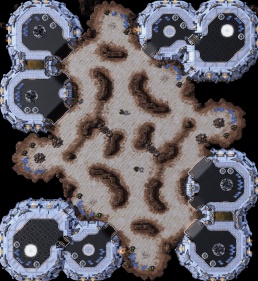 Key features:
Key features:
A brief analysis of non-standard resource bases:
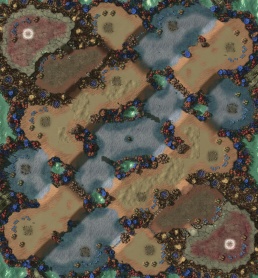 Aggressive map with unusual layout of 16 bases. Rush distance is only 33s and usual thirds have very forward positions and straight attack paths. However, natural has a mineral blocked(30) backdoor ramp that leads to a pocket base. The pocket has another blocked(15) ramp towards the rest of the map.
Aggressive map with unusual layout of 16 bases. Rush distance is only 33s and usual thirds have very forward positions and straight attack paths. However, natural has a mineral blocked(30) backdoor ramp that leads to a pocket base. The pocket has another blocked(15) ramp towards the rest of the map.
Features:
Public voting via TL.net determines the final rankings in TLMC #17. All sixteen finalists, as selected by the judges, receive $200 per winning entry. The top five entrants, as determined by public vote, will be awarded additional winnings as follows:
Maps that place high in TLMC #17 are not guaranteed to be added to the competitive ladder. ESL and Blizzard will reference TLMC #17 and other map-making competitions, and choose which maps to add at their own discretion.
Prize money has been provided by Shopify and ESL, and we thank them for their support of the map making community.
Voting is open for
Voting will be open during October 25-30. The WardiTV TLMC Tournament will be held at the same time with progamers testing out the finalist maps.
Some notes as we unveil the maps:
- All maps are accompanied by comments from the map-maker.
- The maps are listed in random order and do not reflect their score in judge voting.
- Three maps are selected per category based on judging. Then, four additional "judges picks" selections are given to the remaining maps with the highest scores.
Standard
+1 Judges' pick
- Guidelines: Medium sized map. Players tend to have more flexibility on these maps to open with a wider variety of strategies and/or builds.
- Average rush distance (main ramp to main ramp): 33-38 seconds. (Note: Not a hard restriction. Could be more or less)
- Playable map dimensions guidelines (not full map dimensions): Map playable area should be approximately between 15,000 and 17,000. (Note: Not a hard restriction. Could be more or less)
Dragon Scales
By: MiloOnFire Forward high ground outposts play a major part in defense and coordinating attacks. The linear third is open and easy to access, whereas a triangle third is choked, with an option to partially block a ramp with collapsible rocks.
Forward high ground outposts play a major part in defense and coordinating attacks. The linear third is open and easy to access, whereas a triangle third is choked, with an option to partially block a ramp with collapsible rocks.Features:
- Forward expansion on the main attack path.
- Collapsible rocks next to a triangle third base.
- Bridges restricting movements in some parts of the map.
Silver Wall
By: Superouman The Silver Wall has 5 openings where units can pass through. Destroying the rocks in the middle of the map significantly changes the attack routes.
The Silver Wall has 5 openings where units can pass through. Destroying the rocks in the middle of the map significantly changes the attack routes.Starchild
By: Marras Starchild is a standard map with 14 bases, two of which have double rich gasses. There’s also no Overlord pillars at the naturals. Like a typical standard map there are also two third base options, line of sight blockers and some rocks.
Starchild is a standard map with 14 bases, two of which have double rich gasses. There’s also no Overlord pillars at the naturals. Like a typical standard map there are also two third base options, line of sight blockers and some rocks.Ancient Cistern
By: Skypirinha1 A balanced layout which provides room for many different strategies.
A balanced layout which provides room for many different strategies.Rush
+2 Judges' picks
- Guidelines: Map favors early aggression and offensive play.
- Average rush distance (main ramp to main ramp): 33 seconds or less. (Note: Not a hard restriction. Could be more or less)
- Playable map dimensions guidelines (not full map dimensions): Map playable area should be approximately between 14,000 and 16,000. (Note: Not a hard restriction. Could be more or less)
Cryolysis
By: HyperONE Key points:
Key points:- Every base taken, except the triangle 4th, requires defending only one additional choke point.
- The triangle 3rd base has no forward ramp or choke to defend; rather, it has a ramp on the far side of the natural.
- Two narrow horizontal passages lie near the center. You can only feasibly defend one of them at a time. Position your army wisely.
- Although there are no Overlord pillars at the natural expansion, an Overlord can float out of reach of ground units in the dead space near the vespene geysers.
Armistice
By: themusic246 A shorter rush distance and rocks that can open up chokes at key bases pushes the importance of map awareness.
A shorter rush distance and rocks that can open up chokes at key bases pushes the importance of map awareness.Pink Moon
By: monitor Pink Moon is a two-player rush map. The fastest attack path is lined with two inhibitor zones in medium-small choke points. Going around will let players take better engagements, at the sacrifice of longer movement times. The expansion layout follows a fork pattern, with a high degree of symmetry and subtle tradeoffs in the way players choose to expand.
Pink Moon is a two-player rush map. The fastest attack path is lined with two inhibitor zones in medium-small choke points. Going around will let players take better engagements, at the sacrifice of longer movement times. The expansion layout follows a fork pattern, with a high degree of symmetry and subtle tradeoffs in the way players choose to expand.- 12 standard blue expansions.
- Two small inhibitor zones along the central attack path, lined around one side with line-of-sight blockers.
- Three separate sets of 4x4 rocks are located outside of the natural expansion, at the north center ramp, and at the south center ramp.
- No Xel’Naga Towers.
Erreholm
By: volumin Small rush map with 6 bases per player. Main attack route leads through dangerous lowground, side paths are on the high ground, but blocked by long rocks at one point.
Small rush map with 6 bases per player. Main attack route leads through dangerous lowground, side paths are on the high ground, but blocked by long rocks at one point.There is Xel'Naga Tower at 5 and 11 o'clock that gives vision of some of the highground side path, it's hidden behind los blockers.
Babylon
By: Sha This is a fairly small map with standardized expansion patterns that features 4 cliff levels.
This is a fairly small map with standardized expansion patterns that features 4 cliff levels.The reason why I think this map belongs to the rush category even though it has 4 cliff levels (besides short rush distance) is because it features a linear third base relatively open on the low ground, while the triangle third attack path would be straightforward and short if the rocks are taken down. Even if the rocks are not taken down, it's still possible to attack that triangle third from the high ground of the base next to it.
Destroying the destructible rocks will easily shorten the travel time of your attacks and also make them quite straight forward towards the opposing enemy expansions.
Macro
+1 Judges' pick
- Guidelines: A map that favors defensive play and encourages players to reach end game unit compositions.
- Average rush distance (main ramp to main ramp): 38-43 seconds. (Note: Not a hard restriction. Could be more or less)
- Playable map dimensions (not full map dimensions): Map playable area should be approximately between 16,000 and 18,000. (Note: Not a hard restriction. Could be more or less)
Gresvan
By: Legan Macro map with a rake layout of 16 bases. There are forward bases between the usual third base locations. Because the third base opens towards the side and creates a cliff towards the middle, the general movement focuses on a wider choke with line-of-sight blockers and ramp near the triangular fourth.
Macro map with a rake layout of 16 bases. There are forward bases between the usual third base locations. Because the third base opens towards the side and creates a cliff towards the middle, the general movement focuses on a wider choke with line-of-sight blockers and ramp near the triangular fourth.Features:
- Huge rocks at the ramp near triangular third base are supposed to limit where first attacks to triangular third and triangular third will come from.
- Line-of-sight blockers at wide choke on high ground. The two lines are so that approaching the choke from an unusual direction gives you vision to the choke.
- Forward base expensing mineral line to low ground should make it require control over the low ground to an extent.
Black Engine
By: depressed1 Black Engine is a 5-level macro map with a non-standard format of entrance to the natural base. Which allows you to have a split decision on what you want to take as a third base. All levels have at least one fully operating base.
Black Engine is a 5-level macro map with a non-standard format of entrance to the natural base. Which allows you to have a split decision on what you want to take as a third base. All levels have at least one fully operating base.Fifth level was introduced as an experimental part of design. But at the same time it looks natural not only for a base but also for army movements.
Corner bases were pushed at low ground.
The map is relatively medium sized and doesn't have a big number of bases. Only 14 standard bases in total.
The area of the main base is a little bit small for Terran players. But it has been done on purpose. In exchange we have a bigger area of natural base. A place to hide and build a third CC (behind vespene geysers; and if you wanna take a linear third), couple more gates, barracks (less distance to move, or once again to hide them from the opponent). Hiding buildings can be relative to any race. So the decision was not one-sided.
Royal Blood
By: MiloOnFire Despite a short rush distance, this map provides a lot of safety early on by restricting movement of armies and allowing players to expand away from the main attack path. Bases are spread horizontally, and become harder to defend the longer the game goes.
Despite a short rush distance, this map provides a lot of safety early on by restricting movement of armies and allowing players to expand away from the main attack path. Bases are spread horizontally, and become harder to defend the longer the game goes.Features:
- Short rush distance.
- Two building wall-off at the natural expansion.
- Restricted movement due to destructible rocks.
- A forward aggressive option for an expansion.
- Two gold bases with exposed minerals.
Electron
By: Agaton A larger map with baby chokes and shortcuts to keep players on their toes. The linear third expansion is nicely tucked in but has a high-ground with sight-blockers next to it which has to be taken into consideration. The triangular third has several entry points but much tighter chokes. Whatever the choice, the area leading out from the natural provides good flanking opportunities if the attacker overcommits. A Xel'Naga Tower at each side of the center gives vision of important attack paths.
A larger map with baby chokes and shortcuts to keep players on their toes. The linear third expansion is nicely tucked in but has a high-ground with sight-blockers next to it which has to be taken into consideration. The triangular third has several entry points but much tighter chokes. Whatever the choice, the area leading out from the natural provides good flanking opportunities if the attacker overcommits. A Xel'Naga Tower at each side of the center gives vision of important attack paths.Distinctive features:
- Destructible debris closes of larger paths in the early stages of the game
- Small alternative routes are hidden behind line-of-sight blockers.
- Bridges in front of the triangular third are partly blocked by destructible debris to gradually open up the map as the game progresses.
Freestyle
- Guidelines: Maps in this category explore new ideas for how StarCraft II can be played. This category is intended for unorthodox, outside-the-box maps.
- Examples of features that might be included in this category:
- Heavy or atypical usage of backdoor entrances with Mineral Walls/Reduced Mineral Patches.
- Usage of Vespene Geysers as potential gates.
- Inhibitor and Accelerator Zones.
- Non-standard numbers of Mineral nodes or Vespene geysers at bases (Restriction: Values of each individual resource node cannot be adjusted)
- Other strongly non-standard map designs.
- Heavy or atypical usage of backdoor entrances with Mineral Walls/Reduced Mineral Patches.
- Playable map dimensions guidelines (not full map dimensions): Map playable area should be approximately between 14,000 and 18,000. (Note: Not a hard restriction)
Altitude
By: CharactR A Macro map with a bit of a twist! Rich bases in the center are blocked by destructible Xel'Naga towers leaving 3 options:
A Macro map with a bit of a twist! Rich bases in the center are blocked by destructible Xel'Naga towers leaving 3 options:- Destroy the tower to gain access to the rich minerals or to keep it from your opponent.
- Use the watchtower.
- Long distance mine the rich base at the risk of toppling towers.
Features:
- 16 bases total.
- 14 standard bases.
- 2 rich bases (8 patches 1 geyser) that are blocked by Xel'Naga towers.
- Killing the rock towers destroys the Xel'Naga towers, but allows the player to be able to place expansions at the gold bases.
- If you want to keep the Xel'Naga tower and long distance mine from an expansion placed slightly further away there you are able to. However, this allows your opponent can also block mining partially by toppling the 500hp towers.
Lazarus Wastes
By: HyperONE Key features:
Key features:- The central terrain is inspired by Dreamcatcher. Tanks cannot siege behind a cliff such that they can attack either 3rd base, except near the entrances of that base.
- The first 4 bases for each player are standard, but the remaining 3 bases each have 2 extra mineral patches (10 total patches per base).
- To balance the ability to take these bases (especially considering the rate at which different races expand), they are slightly distant, and blocked by debris which must be cleared prior to taking them. Your army becomes a resource which must be used to clear expansions, in addition to the usual attacking and defending.
- If players do not wish to interact with the blocked expansions, they can simply play off the first 4 bases.
A brief analysis of non-standard resource bases:
- Compared to a standard 8-patch base, a 10-patch super-saturated base has no objective downsides.
- Compared to a 6-patch rich mineral base, a 10-patch super-saturated base provides more total resources and boasts ~14% higher income at full saturation. However, the rich base provides ~40% more income per worker and can be saturated more quickly.
Taitalika
By: Legan Aggressive map with unusual layout of 16 bases. Rush distance is only 33s and usual thirds have very forward positions and straight attack paths. However, natural has a mineral blocked(30) backdoor ramp that leads to a pocket base. The pocket has another blocked(15) ramp towards the rest of the map.
Aggressive map with unusual layout of 16 bases. Rush distance is only 33s and usual thirds have very forward positions and straight attack paths. However, natural has a mineral blocked(30) backdoor ramp that leads to a pocket base. The pocket has another blocked(15) ramp towards the rest of the map.Features:
- Mineral patches in the mineral wall on the ramp between natural and pocket are 30 per patch. 30 minerals is so that a single MULE drop doesn’t let Terrans take the pocket too easily.
- Mineral patches in the mineral wall on the ramp between pocket and rest of the map are 15 per patch. Thus builds that require sending 3 workers are possible. Note that it is easy to increase the amount to 20 if this turns out to be too abusive. This can be done in the iteration phase. However there is still quite distance between pocket and main so for example shield batteries or siege tanks do not reach main from the pocket.
- There are 6x6 rocks on the ramp at the middle to give narrow choke to set up defenses against early attacks.
- There are huge rocks on ramps between low ground at the middle and high ground at the corners. They make maneuvering between attack paths harder early.
Voting
TLMC uses a voting system where voters assign points to their top five maps in order of preference. Please follow these instructions when voting:- You may only vote for a total of FIVE (5) maps.
- Among your top five maps picks, assign your points/votes as follows:
- Highest rated map: 5 points
- Second highest rated map: 4 points
- Third highest rated map: 3 points
- Fourth highest rated map: 2 points
- Fifth highest rated map: 1 point
- Highest rated map: 5 points
- You may only assign each specific point value once (only one map can be awarded 5 points, etc).
Vote Now!
Public voting via TL.net determines the final rankings in TLMC #17. All sixteen finalists, as selected by the judges, receive $200 per winning entry. The top five entrants, as determined by public vote, will be awarded additional winnings as follows:
First - $800
Second - $500
Third - $250
Fourth - $150
Fifth - $100
Second - $500
Third - $250
Fourth - $150
Fifth - $100
Maps that place high in TLMC #17 are not guaranteed to be added to the competitive ladder. ESL and Blizzard will reference TLMC #17 and other map-making competitions, and choose which maps to add at their own discretion.
Prize money has been provided by Shopify and ESL, and we thank them for their support of the map making community.
Voting is open for


